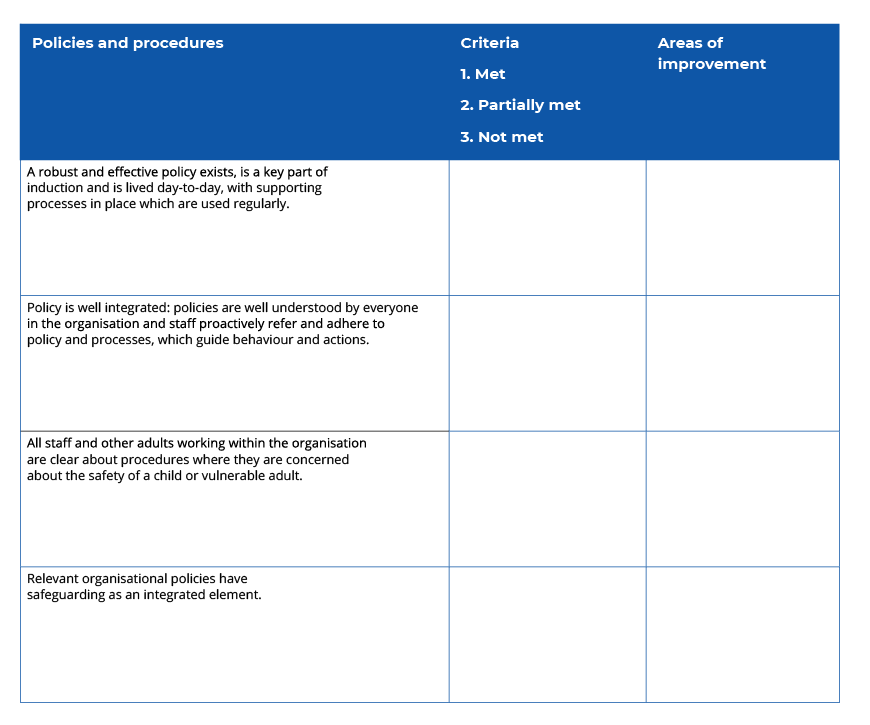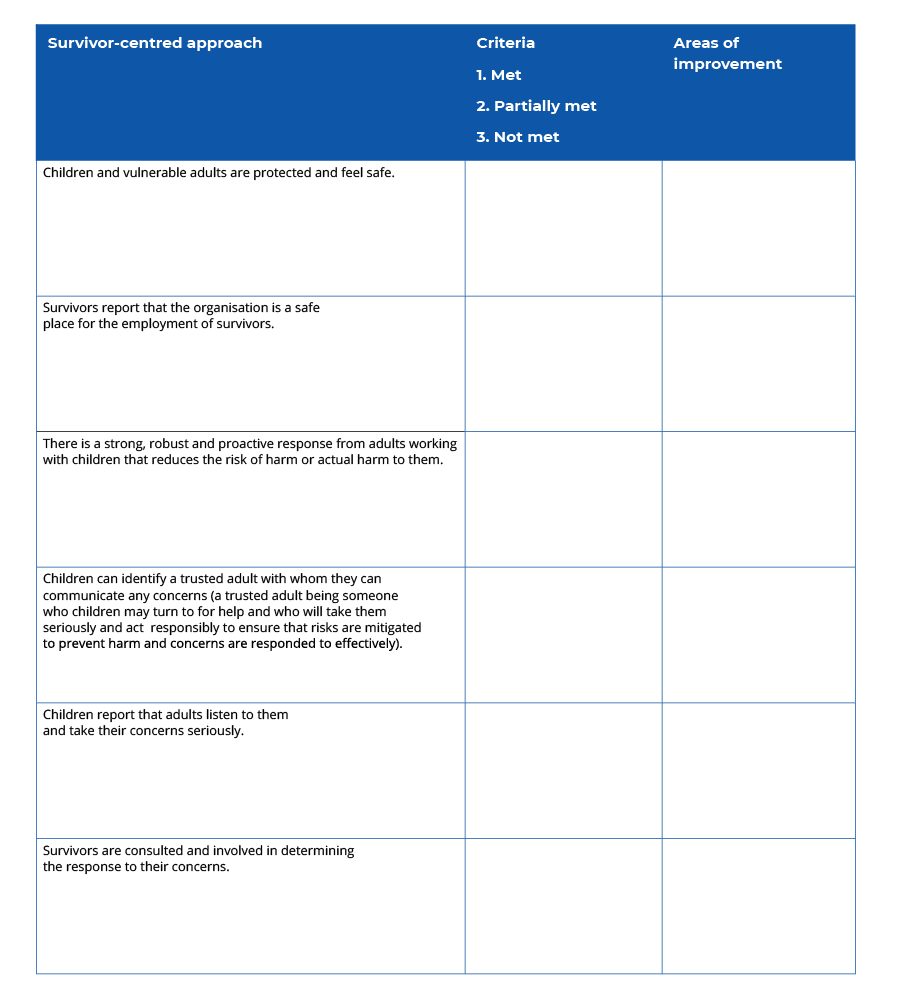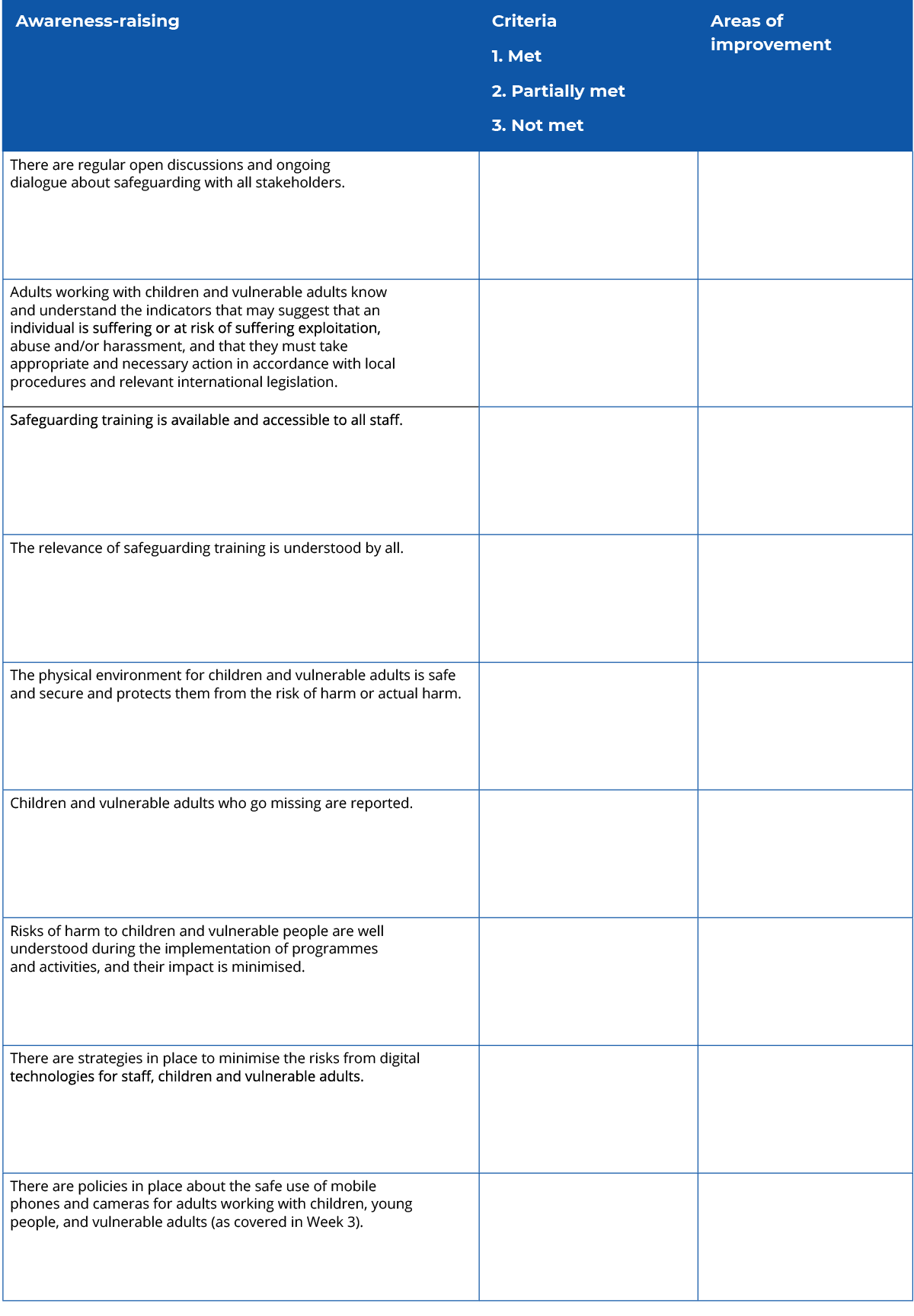Unit 6: Learning and organisational culture
| Site: | OpenLearn Create |
| Course: | Implementing Safeguarding in the International Aid Sector |
| Book: | Unit 6: Learning and organisational culture |
| Printed by: | Guest user |
| Date: | Tuesday, 25 November 2025, 3:11 PM |
Introduction
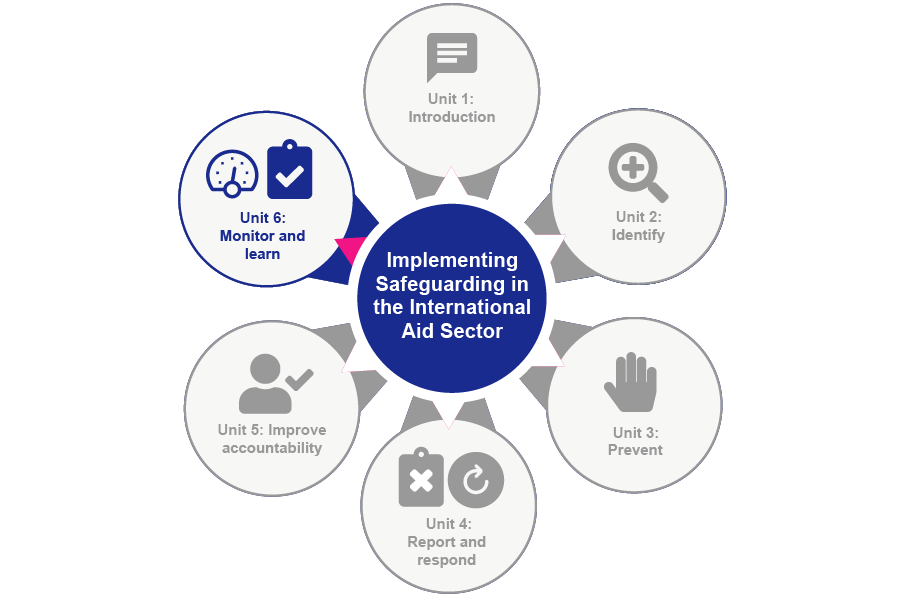
Congratulations on getting to the final unit for this course – Unit 6! This unit focuses on monitoring and learning when implementing safeguarding in our organisations.
It provides an opportunity to reflect on what you already know through your study so far, as well as your experience of safeguarding from your practice.
The key themes of Unit 6 are:
- Strengthening a safeguarding culture within organisations.
- Strengthening report handling mechanisms.
- The importance of good and regular supervision.
- Embedding learning – from managing safeguarding concerns to preventing harm from occurring in the first place.
As you work through this unit, the narrative and the activities enable you to reflect on, update and further develop your knowledge and practice of safeguarding to protect people from all forms of harm. Implementing this knowledge to strengthen a safeguarding culture in your organisation also brings about greater accountability in the international aid sector.
These activities, together with the tools you have learnt to apply on this course, will help you to apply your learning and further understand roles and responsibilities across safeguarding in organisations working in the international aid sector.
To test your knowledge and understanding to date, take a moment to reflect on the following statements and record whether you think they are correct or incorrect.
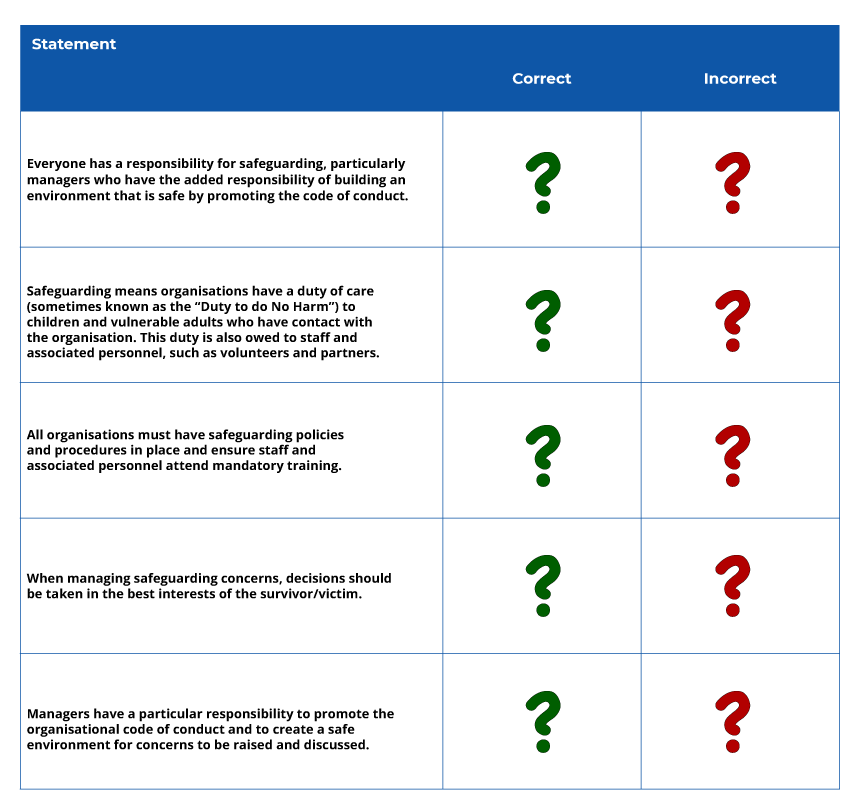
Well done if you noted that all the statements are correct. But how can you be sure that your organisation is taking steps to uphold these statements?
To do so we must monitor and learn to gauge how well we are implementing safeguarding in our organisations, and we need to develop a positive culture that supports safeguarding.
6.1 A positive safeguarding culture

© Shuang Wang/Dreamstime.com
We also know that policies and procedures alone are not sufficient for safeguarding to succeed. Organisations should cultivate an organisational culture through effective strategy and leadership that will benefit safeguarding.
Culture can be difficult to articulate and analysing the culture of an organisation can be particularly challenging to do from within. ‘Organisational culture’ is often described as the personality of that organisation – ‘the way we do things around here’. It encompasses the underlying values, beliefs and codes of practice that make an organisation what it is. It can be seen through behaviour, language, customs, rules, group interaction and habits (Williams, 2018).
Monitoring and reviewing organisational culture is pivotal to effective safeguarding. The way organisations treat their staff and representatives reflects on how they treat their partners and those they seek to help.
Organisational culture is the basis for safeguarding in an organisation: the culture should provide an environment where people feel safe to engage, where anyone in or impacted by an organisation is empowered to report concerns when they arise (Bond 2021).
A positive culture establishes behaviours that support safeguarding as the correct way to behave. It should provide a ‘culture and ethos with values and behaviours that are articulated and lived at each level of organisation’ (Wonacott and Carmi, 2016).
Obviously, for a safe organisational culture to be effective and successful it needs to embed the right values and behaviours that should be articulated at every level of an organisation.
How to develop a positive safeguarding culture

© ANDREI NIKOLAEV / iStock / Getty Images Plus
It is important to have a positive culture in place to ensure the robust implementation of safeguarding measures.
The protection and wellbeing of everyone involved in your organisation’s work must be central to everything that you do and must do more than just meet minimum compliance standards. This will encourage people to feel safe to come forward and raise their concerns.
This last point is particularly important, reflecting the principles of collaborative and inclusive learning with all stakeholders involved, including those who are often marginalised and excluded.
A successful organisational safeguarding culture should exist where organisations:
- Have articulated a commitment to a zero tolerance to all forms of harm, particularly sexual misconduct.
- Have managers who lead by example and foster good relationships with their staff.
- Have in place accessible, safe and confidential reporting mechanisms (respecting anonymity if required).
- Take complaints and concerns seriously and have put steps in place to safeguard the complainant.
- Provide independent whistleblowing procedures that everyone is aware of and which clearly explain how to report a concern and to whom.
- Undertake risk assessments for safe programming and activities.
- Provide safe spaces to challenge conscious or unconscious bias against gender, disability, age or any other discriminatory factors.
- Make decisions in the best interests of the survivor (survivor-centred).
- Ensure that there are clear and trusted whistleblowing processes in place, ideally external to the organisation.
|
Drawing on your learning of the principles of accountability and survivor-centredness in Unit 5, reflect on what the impact would be for survivors and other staff if the culture is not supportive and respectful to them. |
6.2 The role of leadership

© phototechno / iStock / Getty Images Plus
The tone and culture in an organisation is often set by the behaviour of those in the leadership team. You will remember Principle 6 of the IASC PSEA Task Force standards states:
Humanitarian workers are obliged to create and maintain an environment which prevents sexual exploitation and abuse and promotes the implementation of their code of conduct. Managers at all levels have particular responsibilities to support and develop systems which maintain this environment.
Therefore, managers at all levels must steer the development, communication and reinforcement of a positive safeguarding culture. Everything that leaders communicate, say or do is visible and has an influence on the rest of the organisation.
Some practical and meaningful ways that leaders impact the culture include:
- The extent to which their words match their deeds and how this is handled when they don’t.
- The way in which they are seen to handle failure.
- The way in which their values are seen to be lived and acted out.
- The way in which their interactions and relationships with other senior managers are experienced by the wider organisation.
- The decisions they make about who is hired and who is fired, and why.
- The decisions they make about who is valued and rewarded, who isn’t, and why.
- The systems and processes that they champion and prioritise.
Organisations that encourage open conversations about safeguarding, and where suspected or alleged abuse and neglect can be readily reported, will have a strong culture of safeguarding and are more likely to be in a better position to mitigate against risk, prevent harm and respond effectively.
It is also essential that each member of staff feels that his or her dignity is recognised and respected through an ethos of nurturing a supportive workplace and is respectful towards each other. A respectful workplace brings enormous benefits to organisations and there are negative ramifications of not paying enough attention to this.
It is important that Safeguarding Leads and senior colleagues:
- Make support available for anyone raising concerns. This could include having Safeguarding Leads/focal points or champions.
- Encourage staff to look out for changes in the behaviour of children, vulnerable adults, staff and associated personnel that they work with, as this could indicate exploitation, abuse, and harassment.
- Ensure that any changes or other concerns are recorded and shared as soon as possible within the confines of confidentiality, and immediate action is taken if exploitation abuse or harassment is considered or suspected.
|
Activity 6.1 Case study Read the case study below and consider the following questions:
ABC-AID is an international NGO working with refugees and displaced populations. It has a zero tolerance toward sexual misconduct and all staff and associated personnel are requested to sign the code of conduct. Pedro is a driver for ABC-AID and recently Hami, the senior medical officer, asked Pedro to bring two refugee girls from the camp to a nearby guesthouse to meet Hami. Hami is well connected with local politicians and gets on very well with senior management. Pedro complied with Hami’s request, but it made him feel uneasy. Pedro was later reminded that not reporting safeguarding concerns, especially sexual misconduct, would also be a breach of the code of conduct, and he could get into trouble if it ever came out. He spoke to Mary, the field coordinator. Mary, the field coordinator did not know what to do, so she emailed the deputy director. The deputy director was on leave and learnt about the driver’s story when he returned two weeks later. He then informed the country director. The country director decided to do a preliminary investigation and asked Mary, the field coordinator, to ‘find out what was going on’. All the senior staff working in this location live together in a shared house and get on very well together. In the meantime, one of the girls, aged 14, who had been taken to the guesthouse, approached Ling, the co-ordinator of a gender-based violence programme, run by a different NGO. News had reached her father of her sexual relationship with an aid worker, and her father had beaten her and then thrown her out of the family home. Ling informed the United Nations High Commissioner for Refugees (UNHCR, the UN’s Refugee Agency) that the girl was in need of housing and support, using the radio, as this was the only means of communication. The UNHCR, which funds ABC-AID, reported its concerns to ABC-AID and insisted they proceed with an internal investigation immediately. When the allegations were substantiated at the end of an independent investigation, the country director did not want to start disciplinary proceedings against Hami, as Hami was well-connected to local politicians. (© Adapted case study from CHS Alliance, PSEA Investigations Training Toolkit) |
|
Activity 6.2 Organisational culture interview Watch the video above from WaterAid regarding organisational culture and working with partners during the Covid-19 pandemic. Having watched the video, reflect on the following question and make notes in your learning journal:
|
6.3 Useful tools to reflect on safeguarding values

© MaksimYremenko / iStock / Getty Images Plus
Whether explicit or implicit, organisational values guide decision-making. Safeguarding policies should all reflect that ‘safeguarding is everyone’s responsibility’.
However, while this might exist in your policy, is the understanding of this value the same at governance, leadership and staff levels? Or even with other learners undertaking this course?
In her book on creating a sustainable culture, Perkins (2019) suggests that four sets of questions can help to explore values and culture. These four sets, whilst not written for the international aid sector specifically, can be applied to this context by providing a useful tool on how to reflect on the safeguarding values of your organisation.
The questions are detailed below and provide a tool to critically evaluate the values that underpin your organisation’s safeguarding culture.
Review your stories:
- Is there an understanding of safeguarding in your organisation? When a culture reflects on the experiences of members of an organisation, we can sometimes gain insight into the factors that influence the behaviour of people who work for or represent the organisation.
Explore how staff perceive safeguarding leadership:
- Does everyone know how to achieve and communicate organisational vision and values to others? For example, we might talk about valuing every child and vulnerable adult, but does everyone see this and value it in all aspects of the organisation such as fund raising, operations and its programmes?
- Is safeguarding integral to all programmes at all times or is it only considered when donors demand it, such as in due diligence assessments? Perkins (2019) argues that exposing divergences can allow work to be undertaken which, in this context, will adapt and improve the safeguarding culture of an organisation.
Observe behaviours:
- Do your values come through in the work that is undertaken within your organisation? What do you see your staff or other colleagues doing?
- Are colleagues approachable to raise concerns?
- Do they truly listen to partners and the recipients of the services or programmes?
- Do staff and/or beneficiaries come forward to report? Do they trust the reporting mechanisms?
- Are there some staff who exempt themselves from the behaviour of the rest of the system?
- Is there data that clearly indicates trends on perspective of behaviour? For example, gender-based violence (GBV) prevails across class and cultural boundaries, but do people come forward with concerns, or does it remain hidden?
Discuss together how safeguarding values are interpreted:
- Do you have regular conversations with leaders, your staff, and colleagues about safeguarding within your organisation?
- Does everyone demonstrate the same values when you have these discussions?
- Do senior leaders regularly share insights around safeguarding that bring the issues to life in a meaningful way for staff? This is one way of helping all to interpret safeguarding values in the same way. An effective safeguarding culture will evidence this.
- Do leaders demonstrate ‘doing the right thing’ for survivors by placing them at the heart of their response, even above the interests of the organisation (for example, the risk to fundraising) and do they ensure there is a strong track record of support? (Bond, 2021)
![]()
You can explore this issue further through the following readings:
- A respectful organisational culture is crucial to safeguarding (Williams/Bond, October 2018)
- Improving Safeguarding and Culture at Oxfam (Oxfam, October 2020)
Report handling mechanisms
At the core of effective safeguarding systems and processes will be a robust system for handling reports to ensure an effective safeguarding response for everyone, including children and vulnerable adults.
This happens through carefully managed information sharing within the confines of confidentiality and timely safeguarding responses. You will have seen in the earlier case study of ABC-AID that there was no such system to record and share information on a need-to-know basis in line with data protection laws and good practice.
Such a system would allow concerns to be tracked and monitored. It would also help to gauge the number of complaints and concerns received and help identify patterns, themes or trends.
Policies and systems need to be clear as to who can log concerns and incidents. They need to state who will update case files through the life of a case, specifying what data needs to be recorded when. There needs to be clear guidance on who has access to the different safeguarding documentation and records, and how to escalate matters to law enforcement or other external bodies.
And when a case is closed there should be a list of who needs to be informed, and a way that the learning from the case can be harnessed and disseminated through the organisation. The safeguarding focal point and senior leadership team oversee all the above. Robust and safe complaints mechanisms will help share staff perceptions, behaviours and culture within the organisation.
|
Activity 6.3 Improving you report handling mechanisms
|
![]()
Further reading
Developing and modelling a positive safeguarding culture: A tool for leaders (Bond)
Timeliness

© tommy / Getty Images
You would have noted from the ABC-AID case study that there was a considerable delay in raising concerns which had an impact on the lives of the child survivors in that case.
Such concerns would also have had a huge impact on the name and reputation of the organisation and the international aid sector.
Organisational safeguarding policies should detail the following:
- What, how and where to record concerns?
- Who to share information with, and for what purpose?
- How to make decisions and processes based on risk assessments?
- Cover actions required for the survivor/victim(s) as well as the Subject(s) of Complaint.
- Service providers, who have been assessed in their capacity to respond to diverse individuals, need to be mapped out and included in a referral pathway that links with the safeguarding report-handling mechanism. This should be regularly updated.
- Support for staff survivors must be explicitly explained. Confidentiality issues may be more complex in these scenarios.
Remember: there should always be a timeframe for actions as some aspects of safeguarding have life-and-death consequences. Others may impact on long-term mental and physical health, psychosocial wellbeing, and the livelihoods of individuals or safety considerations for wider staff or community members.
It is important to respond quickly to enable the Safeguarding Lead or investigations teams to gather evidence; accurately record the incident details as recalled by the survivor or witnesses; ensure the immediate safety of parties to the incident; and prevent further incidents or harm from occurring.
A timely response to any incidents or concerns shared with the organisation also shows respect for all those involved.
Safe spaces
The ABC-AID case study also demonstrates that policies and processes can be in place, and yet safeguarding incidents and breaches of policies and processes can still happen.
Being mindful of the need to constantly strengthen your safeguarding culture is part of the role description for Safeguarding Leads and senior leadership teams.
But what does this look like?
- Ensuring that there are safe spaces for staff and others to speak out against poor practice and areas of concern without imposing sanctions.
- Listening.
- Sharing what’s working in implementing safeguarding and learning from others.
- Providing avenues to help and support when a concern is identified.
Of course, it is not always easy to challenge poor practice. It can be difficult and takes courage, as in some situations there may be unpleasant consequences for all those involved.
As a Safeguarding Lead or focal point, here are some tips:
- Ensure you are familiar with local policy for raising safeguarding concerns within your organisation.
- Seek support as soon as possible. Ask yourself – do I need some help here? Do you need to talk to a relevant colleague or your manager?
- If the behaviour is one that has low-lying risk, could you talk directly to the person whose behaviour you have concerns about?
- If the answer to question 3 is no, escalate your concern to a more senior colleague in the organisation or, if you do talk to the person directly but still have concerns, you will also need to escalate these. Remember: such concerns may relate to one individual’s behaviour towards another, a child or vulnerable adult, or they may relate to a lack of response to a concern.
- Keep a log/timeline and record your concerns and notes from any related conversations. However small the concern is, it is important to keep a written record as it could escalate at a later date and your evidence may be required as part of the reporting process.
- Whatever role you have, remember you have a responsibility to speak up and raise your concerns if you believe there is a risk to a child, vulnerable adult, colleague or any other.
All staff and volunteers should feel empowered and supported to challenge poor safeguarding practices and feel confident that their concerns will be followed. It is equally important that organisations listen to concerns and address them quickly. This will provide a safer organisational culture for all.
Confidentiality
As a child, did you ever play a game called ‘Whispers’?
This is where everyone stands in a line or a circle. The first person has some important information and whispers it into the ear of a second person. The first person is not allowed to repeat it. The second person then whispers what he or she heard to the third person. The third person then whispers what she or he heard to the fourth person and so on. At the end, the last person in the line or circle reveals what they heard. It is usually completely different from what the first person said!
Reflect on the learning of this game. If someone is concerned and they talk to someone about it, that second person will repeat what they think they heard to the third person, and so on. It’s how rumours start, and while all this is going on, more victims could be abused because no one is taking any effective action!
To prevent rumour mongering and safeguard confidentiality and privacy for survivors/victims as well as for Subjects of Complaints, it is important that everyone in your organisation understands who is responsible for safeguarding and how to reach them.
6.4 Monitoring, learning and good supervision
Monitoring tools to measure safeguarding
It’s important that organisations monitor the progress they have made in implementing the many safeguarding measures they may have identified and developed since they started their safeguarding journey.
For example, when monitoring safeguarding practice and culture in education, the Girls’ Education Challenge developed a monitoring tool which includes monitoring the knowledge and awareness of teachers to ensure they understand their safeguarding responsibilities.
To elicit feedback and complaints from students, they hold focus group discussions by undertaking a risk assessment to ensure no further harm ensues from the activity.
Other possibilities might include surveys (including e-surveys) and focus groups to gage feedback and monitor how safeguarding measures and being implemented.
Action Learning Sets
Action Learning Sets (ALS) is a process that was developed in the 1950s.
ALS is a simple but powerful way for individuals to learn from each other and identify actions which could make a positive difference.
The emphasis is on learning from real experiences and challenges, using the knowledge and skills of small group stakeholders, and utilising skilled questioning to produce fresh ideas for action.
The questions used during the session could be:
- What do we really want to achieve?
- What is stopping us?
- What could we do about it?
- Who has knowledge that we could use?
- Who has an interest in solving the problem?
- Who has the power to get something done?
(Source: Reg Revans, Action Learning)
Learning reviews
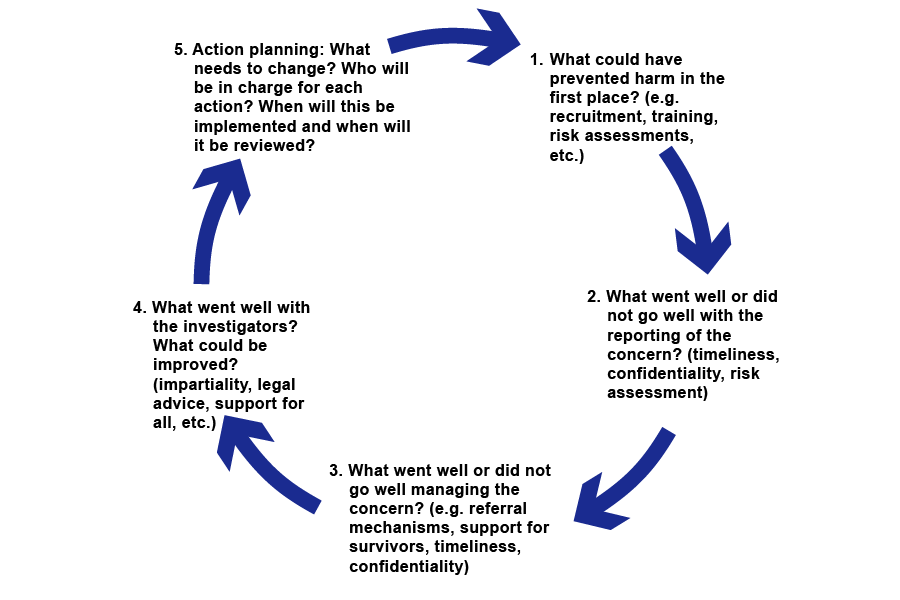
(© Adapted from Child Safeguarding Practice Review, Working Together, 2018)
It is good practice for organisations to hold learning reviews whether there has been a ‘near miss’ or a full investigation into a safeguarding concern.
The purpose of a learning review is to:
- Identify improvements to be made to safeguard and promote the welfare of victims/survivors.
- Seek to prevent or reduce the risk of recurrence of similar incidents.
- Establish whether there are lessons to be learnt from the case about the way in which organisations can work in a safer way.
- Identify clearly what those lessons are, how they will be acted upon, and what is expected to change as a result.
- Improve internal and inter-agency working.
Learning reviews should be facilitated by someone who was not involved in the managing or investigation process of the safeguarding concern. Those who were involved could either write in their feedback or be present at a meeting where views are elicited to the questions in the diagram above.
Questions the learning facilitator could ask include:
- What went well with the reporting of the concern? What could be improved on?
- What went well with the organisational management and response to the concern? What could be improved on?
- What went well with the investigations to that concern? What could be improved on?
- What went well with the next steps to the concern. What could be improved on?
It’s important for organisations to set aside time and a safe space to reflect on their safeguarding practice, particularly after a near miss or investigation.
Safeguarding people is an emotive and sensitive subject. It’s important that everyone understands that it is a collective effort to improve the culture and requires practice within the organisation to keep people safe.
Embedding a culture of learning is not about blaming anyone, but rather clarifying how organisational factors can cause harm, using techniques to avoid bias, being factual, telling it as it was, transparency and accountability.
|
Have you ever used a learning review in your organisation? Might they be helpful in identifying valuable learning from previous experiences? |
Good supervision
![]()
Watch the video above in which Sherine, a learner on this course, has a question about learning reviews.

A key monitoring tool for good safeguarding culture is supervision.
This is an important role for line managers, and they need to know how to manage those who are in stressful positions, such as Safeguarding Leads or focal persons.
You can be supported using good supervision methods such as:
Reflective supervision
These are sessions which allow you the opportunity to discuss uncertainties and to explore your practice critically but in a supportive and safe context. Reflective supervision sessions involve thinking through previous practices and exploring what happened, what you did, and why you made decisions and acted or behaved in particular ways. Discussing how you feel about the actions of others is also important.
Reflective supervision enables continual learning by identifying what you did well, what you could have done better and what you will do next time.
Collaboration supervision
The concept of collaboration (or teamwork) emphasises sharing the responsibility and control of power. Power can be derived from many sources, among them being the position in the organisation, the ability to lead and inspire, the sphere of influence, and the network of colleagues. But most of all, power is derived from knowledge – about children and families, about the field, and about us in the workplace.
While sharing power is the goal of collaboration, it does not exempt supervisors from setting limits or exercising authority. These responsibilities remain firmly within the supervisor’s domain. Collaboration does, however, allow for a dialogue on issues affecting the staff person and the programme.
Regular supervision
Neither reflection nor collaboration will occur without regular interactions. Supervision should take place on a reliable schedule, and sufficient time must be allocated to its practice. Supervision time is precious and may be hard to come by. It should therefore be protected from cancellation, rescheduling or procrastination.
(Source: ZerotoThree)
Supervisors should be actively listening during supervision. The supervisor provides an empathetic, non-judgmental ear to those they supervise. Working through complex emotions in a ‘safe place’ allows the supervisee to manage the stress they experience on the job. Good supervision requires open communication which flows freely in both directions and is protected from ‘outsiders’. Both parties assume the best about each other.
The supervisory relationship is one characterised by a feeling of trust and safety, where difficult issues can be discussed without fear of judgment, disclosure, or ridicule. Open communication implies curiosity and active listening
Show respect to each other and treat others as you would want to be treated in the discussion forum. Remember to keep confidentiality and not reveal identifying details of children or vulnerable adults in your comments.
|
Activity 6.4 Checklist on a good safeguarding culture We are concluding this unit with some checklists which you can use to review aspects of your organisation’s safeguarding culture. They are on policies and procedures, a survivor centred approach, and awareness raising. For each statement in the tables consider how your own organisation compares and identify any areas for improvement. Here is a writable version of each template shown below. You can type into this PDF form and then save it and/or print it. Policies and procedures
Survivor-centred approach
Awareness-raising
(Source: 20 core elements: a toolkit to strengthen safeguarding report-handling – Bond, 2019) |
6.5 Unit 6 Knowledge check
The end-of-unit knowledge check is a great way to check your understanding of what you have learnt.
There are five questions, and you can have up to 3 attempts at each question depending on the question type. The quizzes at the end of each unit count towards achieving your Digital Badge for the course. You must score at least 80% in each quiz to achieve the Statement of Participation and Digital Badge.
6.6 Congratulations on completing this course
![]()
Watch the video above where the Lead Academic, Jan Webb, congratulates you on completing this 24-hour course Implementing Safeguarding in the International Aid Sector.
The video explains that there is a third and final course in this series Leadership in Safeguarding in the International Aid Sector, which is now available as a course on OpenLearn Create).
We are pleased to inform learners that we have also produced a new training aid called Safeguarding in the International Aid Sector: Training Toolkit.
This toolkit has been created to support you to disseminate the learning from Courses 1 and 2 to other people in your organisation and/or people in your partner organisation.
6.7 Review of Unit 6

© Feodora Chiosea / iStock / Getty Images Plus
In this final unit of the course, we focused on how you can implement your knowledge and skills to strengthen your organisation’s safeguarding culture.
The content provided opportunities for you to reflect on your knowledge and skills and how you might also use them to strengthen a safeguarding culture within the international aid sector. There is a lot of guidance on safeguarding in the international aid sector, and a mandate for organisations to designate Safeguarding Leads at senior leadership and board levels.
It is also important that every member of an organisation understands the safeguarding policy and relevant legislation and is effectively and regularly trained in safeguarding throughout their career. Safeguarding training should occur at every level and for every role.
We also applied our learning to a case study related to strengthening a safeguarding culture. The case study and the video with WaterAid further highlighted the importance of implementing knowledge and skills at an individual and organisational level to embed and strengthen a safeguarding culture.
|
Learning journal Before you finish Unit 6, reflect on your own learning so far. Consider the following questions and respond to them in your learning journal:
|
Post-course survey
Please Ctrl + click on this post-course survey that will take about 5 minutes to complete.
Your feedback will additionally help the academic team gauge if this course has made any difference to your knowledge, skills, practice or your confidence level. All responses are anonymised, so we are not able to know or identify individual respondents.
Thank you in advance!
![]()
Further reading
Facilitator’s Guide to Organisational Values and Culture RSH
References
Bond (2021) Understanding effective safeguarding culture: A toolkit to help organisations understand the behaviours associated with safeguarding culture, Online. Available at Bond (Accessed 20 September 2021).
Bond (2019) 20 core elements: a toolkit to strengthen safeguarding report-handling, Online. Available at Bond (PDF) (Accessed 20 September 2021).
Perkins, K. M. (2019) Leadership and Purpose: How to create a sustainable culture, London, Routledge.
Wonacott, J. and Carmi, E. (2016) Serious Case Review: Southbank International School, Hammersmith & Fulham, Kensington & Chelsea and Westminster LSCB, Online. Available at LSCB (PDF) (Accessed 20 September 2021).
Williams, A. (2018) A respectful organisational culture is crucial to safeguarding, Online. Available at Bond (Accessed 20 September 2021).
Woodhouse, J. (2019) ‘Leading a safeguarding culture’, Safeguarding Network, Online. Available at Safeguarding Network (Accessed 20 September 2021).
Zero to Three (2016) Three Building Blocks to Effective Supervision, Online. Available at Zero to Three (Accessed 20 September 2021).
Acknowledgements
Grateful acknowledgement is made to the following sources:
Every effort has been made to contact copyright holders. If any have been inadvertently overlooked the publishers will be pleased to make the necessary arrangements at the first opportunity.
Important: *** against any of the acknowledgements below means that the wording has been dictated by the rights holder/publisher, and cannot be changed.
Unit 1:
Images
Section 1.2: elenabs / iStock / Getty Images Plus
Section 1.3: Taken from favpng.com
Section 1.5: Bet_Noire / iStock / Getty Images Plus
Section 1.5: BRO Vector / iStock / Getty Images Plus
Section 1.7: ID 103981787 © Pichit Boonhuad / Dreamstime.com
Section 1.6: gmast3r / iStock / Getty Images Plus
Section 1.10: Feodora Chiosea / iStock / Getty Images Plus
Text 1.6: Inter-Agency Standing Committee (2016) Minimum Operating Standards (MOS-PSEA), https://interagencystandingcommittee.org/iasc-task-team-accountability-affected-populations-and-protection-sexual-exploitation-and-abuse/minimum-operating-standards-mos-psea Licensed under a Creative Commons Attribution 4.0 International (CC BY 4.0) license, https://creativecommons.org/licenses/by/4.0/
Video 1.1: Video: © The Open University / Images: Parentingupstream / Pixabay, Udo Voigt / Pixabay, Bernd Müller / Pixabay, Halcyon Marine Healthcare Systems / Pixabay, fernando zhiminaicela / Pixabay, Tammy Lee / Pixabay, felixioncool / Pixabay, Jess Foami / Pixabay, Adabara Ibrahim / Pixabay, go_see / Pixabay, stokpic / Pixabay, criss_chengck10339 / Pixabay, ludi / Pixabay, David Mark / Pixabay, AkshayaPatra Foundation / Pixabay, PublicDomainPictures / Pixabay, EastSons GoodWorks / Pixabay, truthseeker08 / Pixabay, David Mark / Pixabay, Ian Ingalula / Pixabay, AkshayaPatra Foundation / Pixabay)
Videos 1.6, 1.7: Safeguarding Resource and Support Hub
Video 1.8: Created by the IASC in Bangladesh, https://youtu.be/HMrxQ6kjV-o This file is licensed under the Creative Commons Attribution Licence http://creativecommons.org/licenses/by/4.0/.
Unit 2:
Images
Section 2.1 Martin Barraud / Getty Images
Section 2.1: MHJ / Getty Images
Section 2.2: daz2d / Getty Images
Section 2.3: patpitchaya / iStock / Getty Images Plus
Section 2.4: MicroStockHub / iStock / Getty Images Plus
Section 2.4: Panuwat Dangsungnoen / iStock / Getty Images Plus
Section 2.5: Talaj / iStock / Getty Images Plus
Section 2.7: Feodora Chiosea / iStock / Getty Images Plus
Video 2.2: Professor Peter Hopkins, Newcastle University
Video 2.5: Safeguarding Resource and Support Hub
Videos 2.4, 2.5, 2.18: Video: © The Open University (Audio: prosoundfx / Envato Elements, TibaSFX / Envato Elements, GameChestAudio / Envato Elements, sonic-boom / Envato Elements, JiltedGeneration / Envato Elements) (Images: mamanamsai / Envato Elements, barsrsind / Envato Elements, barsrsind / Envato Elements, MaxRiesgo / iStock / Getty Images Plus, creativevip / Envato Elements, MissChatZ / Envato Elements, creativevip / Envato Elements, creativevip / Envato Elements)
Unit 3:
Images:
Section 3.1: Adapted from information on Child Participation, Child to Child, http://www.childtochild.org.uk/
Section 3.4: Hart, R. A. (1992). Children’s participation: From tokenism to citizenship. Florence, Italy: United Nations Children’s Fund International Child Development Centre.
Section 3.2: Marco VDM / Getty Images
Section 3.3: The Lucy Faithfull Foundation
Section 3.3: Photo 143396223 © Kenishirotie / Dreamstime.com
Section 3.3: bgwalker / iStock / Getty Images Plus
Section 3.4: natasaadzic / iStock / Getty Images Plus
Section 3.5: Internet Watch Foundation (2020) Analysis of individual image hashes by age of the child and severity of the abuse, IWF Annual Report 2020, https://annualreport2020.iwf.org.uk/trends/international/overview
Section 3.5: tommaso79 / iStock / Getty Images Plus
Section 3.8: Feodora Chiosea / iStock / Getty Images Plus
Text: 3.2: Watters, L., and Orsander, M. (2021) Disability-inclusive child safeguarding guidelines, Able Child Africa and Save the Children, https://ablechildafrica.org/news/6759/
Text 3.3: Adapted from bond (2019) Safeguarding report-handling mechanism: Case studies (CC BY-NC 4.0), https://creativecommons.org/licenses/by-nc/4.0/
NSPCC Learning, https://learning.nspcc.org.uk/media/1600/online-safety-policy-statement-example.pdf Further resources available at https://learning.nspcc.org.uk/
Video 3.2: © Able Child Africa 2021.
Video 3.2: SENSE International
Video 3.2: SENSE International
Video 3.4: UNICEF Office of Global Insight and Policy
Video 3.5: Video: © The Open University (Audio: prosoundfx / Envato Elements, TibaSFX / Envato Elements, GameChestAudio / Envato Elements, sonic-boom / Envato Elements, JiltedGeneration / Envato Elements) (Images: mamanamsai / Envato Elements, barsrsind / Envato Elements, barsrsind / Envato Elements, PIKSEL / iStock / Getty Images Plus, creativevip / Envato Elements, MissChatZ / Envato Elements, creativevip / Envato Elements, creativevip / Envato Elements)
Video 3.7: Video: © The Open University (Images: StockSnap / Pixabay, RAEng_Publications / Pixabay, Jess Foami / Pixabay, Free-Photos / Pixabay, Div_Iv / Pixabay, CDC / Pexels, Sam Chen / Pixabay, StartupStockPhotos / Pixabay, Freelance Grafiker / Pixabay, Pashminu Mansukhani / Pixabay, SENSE International)
Unit 4:
Images:
Section 4.2: Serhii Radachynskyi / 123RF
Section 4.2: Ponomariova_Maria / iStock / Getty Images Plus
Section 4.2: stock_colors / iStock / Getty Images Plus
Section 4.2: ljubaphoto / iStock / Getty Images Plus
Section 4.3: infografx / 123RF
Section 4.4: danijelala / Getty Imagess
Section 4.5: Christian Horz / iStock / Getty Images Plus
Section 4.5: Photo 108018033 © Rawpixelimages / Dreamstime.com
Section 4.5: baona / iStock / Getty Images Plus
Section 4.5: Adapted from Tool 4: Sexual violence response task list, Global Interagency Security Forum (GISF), https://gisf.ngo/resource/managing-sexual-violence-against-aid-workers/
Section 4.6: natasaadzic / iStock / Getty Images Plus
Section 4.8: Feodora Chiosea / iStock / Getty Images Plus
Text 4.2: Based on Galop (2019) Barriers Faced by Lesbian, Gay, Bisexual and Transgender + (LGBT+) People in Accessing Non-LGBT+ Domestic Abuse Support Services, https://galop.org.uk/resource/resource-f/
Text 4.5: Mapping tool: Adapted from Mapping Tool for GBV Services, IASC PSEA, https://psea.interagencystandingcommittee.org/resources/mapping-tool-gbv-services
Text 4.5: Adapted from Tool 4: Sexual violence response task list, Global Interagency Security Forum (GISF), https://gisf.ngo/resource/managing-sexual-violence-against-aid-workers/
Text 4.6: Megan Nobert and Christine Williamson, Duty of Care: Protection of Humanitarian Aid Workers from Sexual Violence, Report the Abuse, August 2017.
Video 4.3: © E-magination Training
Video 4.5: Video: © The Open University (Audio: prosoundfx / Envato Elements, TibaSFX / Envato Elements, GameChestAudio / Envato Elements, sonic-boom / Envato Elements, JiltedGeneration / Envato Elements) (Images: mamanamsai / Envato Elements, barsrsind / Envato Elements, barsrsind / Envato Elements, MaxRiesgo / iStock / Getty Images Plus, creativevip / Envato Elements, MissChatZ / Envato Elements, creativevip / Envato Elements, creativevip / Envato Elements)
Video 4.6: Video: © The Open University (Images: Lailatul Ferdous / BSMMU Bangladesh, Hannah Olinger / Unsplash, JonHoefer / Pixabay)
Unit 5:
Images:
Section 5.1: phototechno / iStock / Getty Images Plus
Section 5.1: The Open University (Images (left to right): Photo by Redd on Unsplash, Photo by Amy Hirschi on Unsplash, Photo by Headway on Unsplash)
Section 5.1: Vladimir Kononok / iStock / Getty Images Plus
Section 5.2: Enis Aksoy / Getty Images
Section 5.3: ID 144750017 © Fizkes / Dreamstime.com
Section 5.3: ID 67005947 © Aleem Zahid Khan / Dreamstime.com
Section 5.4: ID 74791781 © Rawpixelimages / Dreamstime.com
Section 5.5: GOCMEN / iStock / Getty Images Plus
Section 5.7: Feodora Chiosea / iStock / Getty Images Plus
Video 5.8: © IntegrityAction.org, https://integrityaction.org/
Video 5.12: Nesta, https://vimeo.com/103698691 Licensed under a Creative Commons Attribution-NonCommercial-ShareAlike 4.0 International (CC BY-NC-SA 4.0) licence, http://creativecommons.org/licenses/by-nc-sa/4.0/
Video 5.16: WaterAid
Video 5.21: Video: © The Open University (Images: Plan International Zimbabwe, Lagos Food Bank Initiative / Pexels, L.Steward Masweneng / Unsplash, Danique Tersmette / Unsplash)
Video 5.22: Witness.org, https://youtu.be/K5PBs9vIC4c Licensed under a Creative Commons Attribution-NonCommercial-ShareAlike 4.0 International (CC BY-NC-SA 4.0) license, http://creativecommons.org/licenses/by-nc-sa/4.0/
Unit 6:
Images:
Section 6.1: ID 150858883 © Shuang Wang / Dreamstime.com
Section 6.1: ANDREI NIKOLAEV / iStock / Getty Images Plus
Section 6.2: phototechno / iStock / Getty Images Plus
Section 6.3: MaksimYremenko / iStock / Getty Images Plus
Section 6.3: tommy / Getty Images
Section 6.4: Adapted from Department for Education (2018) Child Safeguarding Practice Review, Working Together, https://www.gov.uk/government/publications/working-together-to-safeguard-children–2 Reproduced under the terms of the Open Government License v3.0, https://www.nationalarchives.gov.uk/doc/open-government-licence/version/3/
Section 6.7: Feodora Chiosea / iStock / Getty Images Plus
Text 6.2: Inter-Agency Standing Committee (2019) IASC Six Core Principles Relating to Sexual Exploitation and Abuse, 2019, 23 September 2019, https://interagencystandingcommittee.org/inter-agency-standing-committee/iasc-six-core-principles-relating-sexual-exploitation-and-abuse This file is licensed under a Creative Commons Attribution 4.0 International (CC BY 4.0) license, https://creativecommons.org/licenses/by/4.0/
Text 6.2: Adapted case study from CHS Alliance, PSEA Investigations Training Toolkit Supervision methods: ‘Three Building Blocks of Reflective Supervision’, Zero to Three, https://www.zerotothree.org/resources/412-three-building-blocks-of-reflective-supervision#chapter-246
Text 6.4: Policies and Procedures: Adapted from Bond (2019) 20 core elements: a toolkit to strengthen safeguarding report-handling, https://www.bond.org.uk/sites/default/files/bond_20_core_elements_a_toolkit_to_strengthen_safeguarding.pdf Licensed under a Creative Commons Attribution-NonCommercial 4.0 International License, https://creativecommons.org/licenses/by-nc/4.0
Text 6.4: Survivor-Centred Approach: Adapted from Bond (2019) 20 core elements: a toolkit to strengthen safeguarding report-handling, https://www.bond.org.uk/sites/default/files/bond_20_core_elements_a_toolkit_to_strengthen_safeguarding.pdf Licensed under a Creative Commons Attribution-NonCommercial 4.0 International License, https://creativecommons.org/licenses/by-nc/4.0
Text 6.4: Awareness raising: Adapted from Bond (2019) 20 core elements: a toolkit to strengthen safeguarding report-handling, https://www.bond.org.uk/sites/default/files/bond_20_core_elements_a_toolkit_to_strengthen_safeguarding.pdf Licensed under a Creative Commons Attribution-NonCommercial 4.0 International License, https://creativecommons.org/licenses/by-nc/4.0
Video 6.2: Video: © The Open University (Images and footage: Mahesh Dhungana - WaterAid Nepal)
Video 6.4: Video: © The Open University (Audio: prosoundfx / Envato Elements, TibaSFX / Envato Elements, GameChestAudio / Envato Elements, sonic-boom / Envato Elements, JiltedGeneration / Envato Elements) (Images: mamanamsai / Envato Elements, barsrsind / Envato Elements, barsrsind / Envato Elements, PIKSEL / iStock / Getty Images Plus, creativevip / Envato Elements, MissChatZ / Envato Elements, creativevip / Envato Elements, creativevip / Envato Elements)
Video 6.6: Video: © The Open University (Images: criss_chengck10339 / Pixabay, truthseeker08 / Pixabay, Gundula Vogel / Pixabay, mamanamsai / Envato Elements, creativevip / Envato Elements, MissChatZ / Envato Elements, MaxRiesgo / iStock / Getty Images Plus, barsrsind / Envato Elements, Brian Odwar / Pixabay, tdam94 / Pixabay, Image by pakkalajuha from Pixabay
